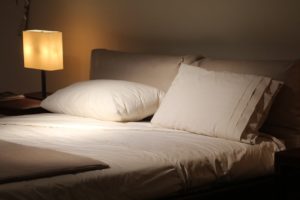- Calls to this hotline are currently being directed to Within Health, Fay or Eating Disorder Solutions
- Representatives are standing by 24/7 to help answer your questions
- All calls are confidential and HIPAA compliant
- There is no obligation or cost to call
- Eating Disorder Hope does not receive any commissions or fees dependent upon which provider you select
- Additional treatment providers are located on our directory or samhsa.gov
Sleep-Related Eating Disorder: Signs, Symptoms, and Prevalence

Contributor: Courtney Howard, B.A., Executive Assistant at Eating Disorder Hope and Addiction Hope
Sleep-related eating disorder (SRED) is a newly recognized condition, first introduced by Dr. C.H. Schenck and colleagues in 1991 [1]. SRED is characterized by consuming large quantities of food over a short period of time during the night, while the individual is asleep. Specialists debate whether it should be classified as a sleep disorder or an eating disorder, since it has trademark components of both.
This is different than nocturnal or night eating disorder (NES), which is an eating disorder associated with insomnia and nighttime binges.
Though often confused for sleepwalking, SRED is also different than this behavior since those with SRED typically do not engage in any activities while asleep other than going to the kitchen, eating food, then returning to bed.
What is Sleep-Related Eating Disorder (SRED)?
SRED is often described as a form of parasomnia, or an undesired occurrence during one’s sleep. Some people do not remember anything about their sleep-eating, while others remember in vivid detail despite having been unconscious.
Individuals who have SRED typically engage in related behaviors on a nightly basis, sometimes having more than one episode per night. These episodes occur regardless of actual hunger or thirst.
There are many potential dangers associated with SRED. As a 2006 [2] scholarly article notes, these include physical injuries while preparing food since affected individuals are typically only interested in food consumption, not proper preparation or clean-up. Another very serious concern is the consumption of non-food items, improperly cooked food, or toxic substances. For example, someone having an episode might swallow cleaning liquid or eat raw bacon.
In addition, food consumed mid-sleep by those with SRED is often unusually high in calories, sugar, and/or fat. People typically make strange food combinations they would never normally consume during waking hours. One common behavior is eating large quantities of peanut butter straight from the jar, which is actually a common binge food among individuals with bulimia nervosa or binge eating disorder (BED).
Signs to Watch For
If you do not remember anything about your SRED episodes, it can be scary to learn that you engaged in these behaviors without your knowledge or memory. Some people do remember eating in their sleep, but for others it can be difficult to put together the pieces of what happened in the middle of the night.
It is common for individuals with SRED to wake up with indigestion or other stomach discomfort. For those who live alone, it can be easier to determine that something unusual happened while you were asleep since those with SRED typically do not clean up after an episode. This setting might include dirty utensils, food containers lying around, and missing food.
If you live with others, these individuals might know you have a problem before you do. They likely witness symptoms on some level, or at least the aftermath. However, they might not know you are asleep during episodes, possibly thinking you are just hungry or come down for a bite when you cannot sleep.
If you suspect you might have SRED, do not hesitate to ask your friends or loved ones about your behaviors. It is worth having an uncomfortable conversation to uncover what is really going on. You can arm yourself with this information before seeking professional help.
Prevalence of SRED
The American Sleep Association reports that SRED is more common among women than men, and that the age of onset is typically early adulthood.
 SRED can be triggered by a recent change in diet, depression, cessation of smoking, or stress, among other life changes. Once underlying triggers are addressed, symptoms of SRED typically dissipate.
SRED can be triggered by a recent change in diet, depression, cessation of smoking, or stress, among other life changes. Once underlying triggers are addressed, symptoms of SRED typically dissipate.
There is also a unique connection between SRED and other eating disorders. While food-related dreams are common among those struggling with eating disorders, researchers suggest that these dreams might become a reality for many with SRED. A 1999 study [3] reported that while SRED affects approximately 5 percent of the general population, it occurs in as many as 9 to 17 percent of individuals with eating disorders.
Sleeping and eating are two primal, necessary acts that most people do without much thought. For those who have disorders relating to either, or both, it can become a daily struggle to maintain mental and physical health.
Getting Help
Many people struggling with SRED feel embarrassed or ashamed about their sleep-eating. This keeps many people from seeking help, though SRED is usually highly treatable.
As previously mentioned, treating underlying mental health concerns or other triggers is often a big piece of the puzzle when it comes to SRED treatment. Certain medications have also proven effective. Find out what works for you by reaching out for help today.
Community Discussion – Share your thoughts here!
Have you or your loved one struggled with Sleep-related eating disorders? What types of treatment and support have been helpful in your recovery?

About the Author: Courtney Howard is the Executive Assistant for Eating Disorder Hope and Addiction Hope. She graduated summa cum laude with a B.A. from San Diego State University, holds a paralegal certificate in Family Law, and is a Certified Domestic Violence Advocate. After obtaining her certification as a life coach, Courtney launched Lionheart Eating Disorder Recovery Coaching in 2015 and continues to be a passionate advocate for awareness and recovery.
References:
[1]: Schenck, C., Hurwitz, T., Bundlie, S., & Mahowald, M. (1991). “Sleep-related eating disorders: Polysomnographic correlates of a heterogeneous syndrome distinct from daytime eating disorders.” Sleep;14(5):419–31.[2]: Auger, R. R. (2006). “Sleep-Related Eating Disorders.” Psychiatry (Edgmont), 3(11), 64–70.
[3]: Winkelman, J., Herzog, D., & Fava, M. (1999). “The prevalence of sleep-related eating disorder in psychiatric and non-psychiatric populations.” Psychol Med.;29:1461–6.
The opinions and views of our guest contributors are shared to provide a broad perspective of eating disorders. These are not necessarily the views of Eating Disorder Hope, but an effort to offer discussion of various issues by different concerned individuals.
We at Eating Disorder Hope understand that eating disorders result from a combination of environmental and genetic factors. If you or a loved one are suffering from an eating disorder, please know that there is hope for you, and seek immediate professional help.
Last Updated & Reviewed By: Jacquelyn Ekern, MS, LPC on August 2, 2016
Published on EatingDisorderHope.com

The EatingDisorderHope.com editorial team comprises experienced writers, editors, and medical reviewers specializing in eating disorders, treatment, and mental and behavioral health.

